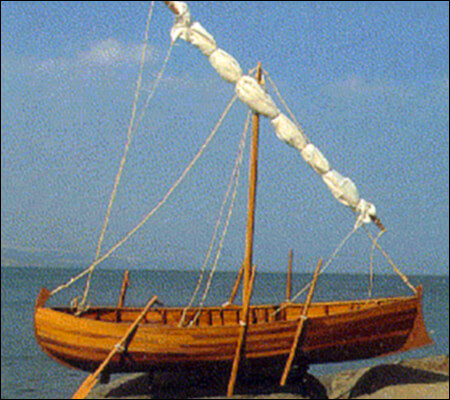Jesus the Boatbuilder and the Ancient Boat
MORE ASTRONOMY / ARCHAEOLOGY / COSMOLOGY
- Architecture of the Universe and the Urantia Book
- Stars, Galaxies, Superuniverses and the Urantia Book
- Monmatia Revisited
- Earth-Moon Evolution
- A Tale of Two Orvontons
- Urantia, 606 of Satania
- Urantia, A Cosmic View of the Architecture of the Universe
- Jesus the Boatbuilder and the Ancient Boat
- Ancient Cyprus
- Did the Jews Really Not Bury Their Dead?
- Atlantis-Eden Parallels
- First Eden/Atlantis Analysis
Why did the revelators tell us so much about the boats Jesus built and designed on the Sea of Galilee? Did they foresee that we would uncover one of those boats in the near future, and put two and two together?
by Saskia Praamsma Raevouri (2010)
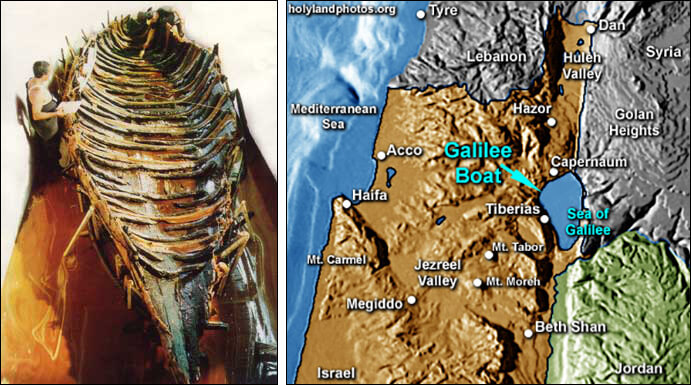
[In January of A.D. 21 Jesus] passed on successively through Magdala and Bethsaida to Capernaum, where he stopped to pay a visit to his father's friend Zebedee.
Zebedee's sons were fishermen; he himself was a boatbuilder. Jesus of Nazareth was an expert in both designing and building; he was a master at working with wood; and Zebedee had long known of the skill of the Nazareth craftsman. For a long time Zebedee had contemplated making improved boats; he now laid his plans before Jesus and invited the visiting carpenter to join him in the enterprise, and Jesus readily consented.
Jesus worked with Zebedee only a little more than one year, but during that time he created a new style of boat and established entirely new methods of boatmaking. By superior technique and greatly improved methods of steaming the boards, Jesus and Zebedee began to build boats of a very superior type, craft which were far more safe for sailing the lake than were the older types. For several years Zebedee had more work, turning out these new-style boats, than his small establishment could handle; in less than five years practically all the craft on the lake had been built in the shop of Zebedee at Capernaum. Jesus became well known to the Galilean fisherfolk as the designer of the new boats. [1419]
WHEN my friend and fellow UB-reader Joy Brandt and I visited Israel in 1998, we stayed on the Sea of Galilee in a kibbutz called Nof Ginosar. In the Urantia Book, this region south of Capernaum is called Gennesaret. Capernaum is where the boat-making establishment of Zebedee was located, where Jesus worked for more than a year.
In 1986, during a drought that drastically lowered the level of the Sea of Galilee, an ancient boat was discovered in the waters off the shore south of the kibbutz. Experts called to the scene agreed it was indeed an ancient boat and excavations were begun immediately, conducted by the Israel Department of Antiquities and Museums assisted by archaeologists and volunteers.
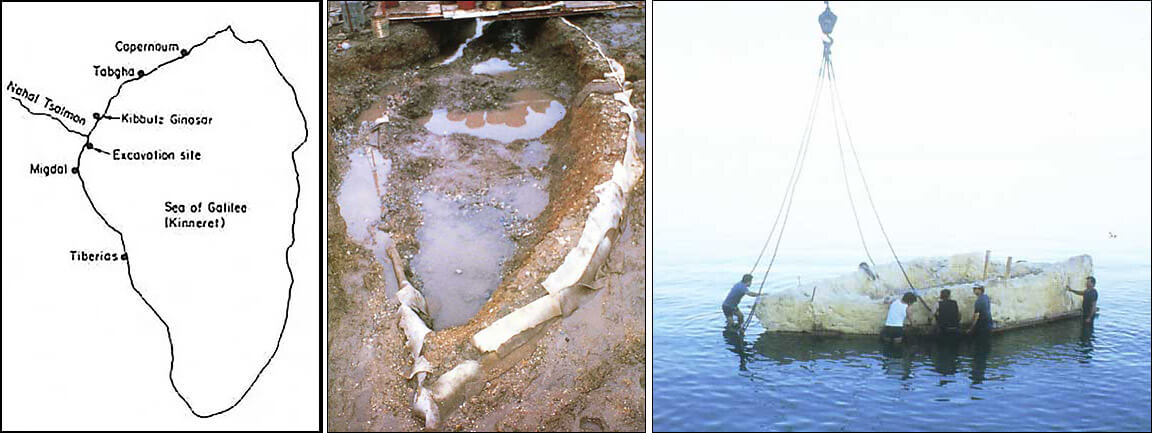
Brittle and spongy, the boat was carefully cleared of the mud that had protected it from deterioration over the centuries, "packaged" in polyurethane foam, floated up the shore and moved to a conservation pool in the Yigal Allon center, a museum on the grounds of the kibbutz. The excavation took eleven days. Here, supported by fiberglass frames, the boat sat for nine and a half years undergoing treatment consisting of impregnation with a special wax material. In 1995 the pool was emptied and the boat revealed. A slow drying process followed but it was viewable behind a glass wall.
After careful study of the methods used in its construction, according to the official booklet from which I gathered this information, experts came to agree that "it was built by a master craftsman or boat builder. The design—a deep, rounded stern and fine bow known as the “shell-first” method—is different than anything previously unearthed, though similar vessels have been represented artistically. The builder followed a common Mediterranean practice with many deviations.
"Frames provided support made from naturally curved tree branches. The shape of the frames and planks are unlike anything thus far recorded for seafaring craft, and indicate either a shortage of good timber or a type of construction adapted specifically to this relatively calm, freshwater lake."
"... during that time he created a new style of boat and established entirely new methods of boatmaking."
"Its planks were assembled with mortise and tenon joints locked in place with tapered wood pegs, and then nailed to the frames with straight iron nails. The nails, some with square, round or octagonal shafts, seem more suited to domestic carpentry, as does the style of their application."
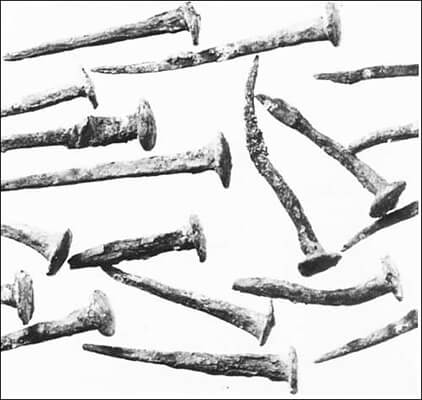
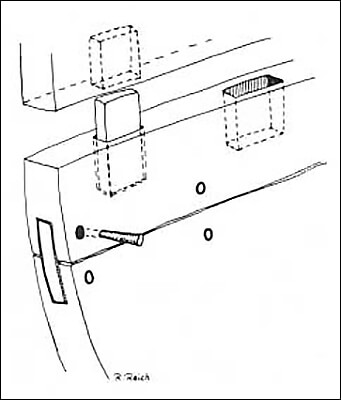

stern, white outlines the planks
"Twelve different kinds of wood have been identified, the most common being oak and cedar, indicating that the builder made use of whatever materials were available locally. Measuring 26.5 long by 7.5 wide by 4.5 feet deep, the boat could carry 15 persons and may have had a mast.
"The boat was repaired many times. The differences between the workmanship of the repairs and that of the original construction suggest that the work was done by different workmen or even perhaps by different generations of workmen.
"Based on a study of construction techniques, Carbon-14 analysis and ceramic chronology, the boat is dated to the period covering the first century BC until the first century AD, a period when the lakeside communities witnessed the ministry of Jesus and his disciples. The vessel, evidently used for fishing and transport, provides a major contribution to the study of water transport and the history of the Galilee area. Today the boat rests on a specially designed steel cradle in the new wing of the museum."
* * *
Joy said, "I think the Jesus boat was one of the highlights of our trip, and that many Urantia Book readers would be interested in it. One of the fascinating things is that in “The Draught of Fishes" section in the Jesus papers, it goes into a couple sentences of detail about the boat that Jesus was standing on:
On Friday morning of this same week, when Jesus was teaching by the seaside, the people crowded him so near the water's edge that he signaled to some fishermen occupying a near-by boat to come to his rescue. Entering the boat, he continued to teach the assembled multitude for more than two hours. This boat was named "Simon"; it was the former fishing vessel of Simon Peter and had been built by Jesus' own hands. [1628]
Joy continues, "If you look up the comparable story about the "Draught of Fishes" in the Bible, you'll find that it took place in Genneseret (Ginosar), which is the name of the kibbutz and thus the location where the ancient boat was found. I think the Urantia Book tells us a little about this boat on which Jesus stood because the midwayers figured that we'd uncover the boat sooner or later."
Another fascinating item mentioned the booklet: "Slightly to the northeast were found fragments of wood which appear to be waste from shipbuilding activities, as well as the remains of two other smaller boats from later periods, indicating that this site may have been a place where boats were built and stored." As we Urantia Book readers know, Zebedee's boatshop was located northeast of Gennesaret, in the very area described.
Did Jesus have a hand in building this boat? Who else but Jesus would have been this "master craftsman"?
